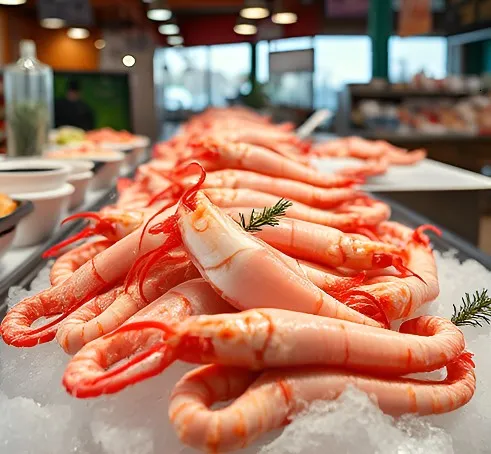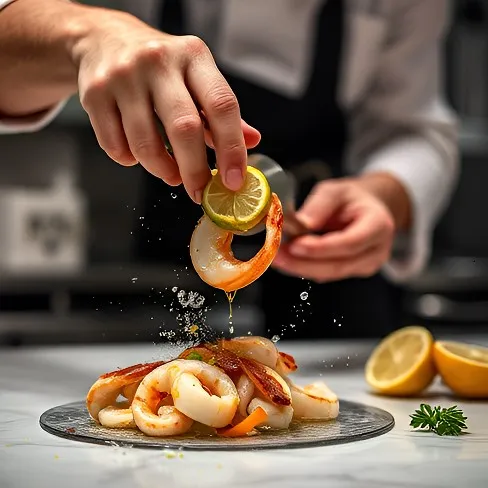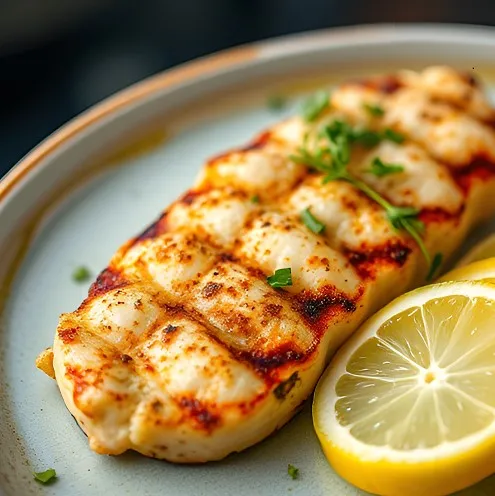Calamari steak is not your run-of-the-mill seafood dish. It refers to a flat, whole cut of squid mantle that is treated much like a traditional steak. Rather than being sliced into rings, the entire mantle is left intact to showcase its hearty texture and delicate flavor when cooked properly. Although the idea conjures images of something unusual when compared to fish or shrimp, calamari steak offers an inviting alternative for anyone looking to try something new at the dinner table.
Table of Contents
Defining Calamari Steak: A Closer Look
At its core, calamari steak is a piece of squid that comes primarily from the muscular body, known as the mantle. Unlike calamari rings, which are thin, bite-size slices often dusted in batter and deep-fried, a calamari steak is a much larger, intact section. The distinction in presentation means that calamari steak is typically served as the centerpiece of a meal, making it not only a protein-packed dish but also a visually appealing one. Its appeal is rising among seafood enthusiasts and diners seeking variety beyond the standard fish fare.
The Difference Between Calamari Steak and Rings
When you glance at a menu, you might see calamari presented in two different ways. On one side, there are the popular rings—quick, crispy, and perfect for finger food. On the other, there’s the calamari steak: a thick, whole slice that demands more attention. Think of calamari rings as the appetizer version and the steak as a main course meant to be savored slowly. The steak’s larger cut means that it has a slightly firmer bite, which if prepared correctly, offers an enjoyable contrast between a tender interior and a crisp exterior when seared or grilled.
Anatomy of a Squid and Its Connection to Calamari Steak
Understanding calamari steak starts with a brief introduction to the squid itself. Squids are remarkable marine creatures, and the part used for making calamari steak is the mantle—the muscular tube that propels the squid through the water. When you slice a cross-section of the mantle into a steak, you get a slice of firm, protein-rich muscle. This cut is prized for its ability to absorb marinades and spices, allowing the natural sweetness of the squid to meld with additional flavors. The unique structure of the mantle is the reason why the dish, when handled correctly, can achieve both tenderness and a slight chew that seafood lovers appreciate.

Flavor Profile and Texture
In terms of flavor, calamari steak is remarkably mild, carrying a subtle sweetness that is reminiscent of a fresh ocean breeze. Unlike some other seafood options, it does not possess an overwhelming fishy taste—making it ideal even for those who might be hesitant about seafood. Texture is another key factor: when prepared properly, calamari steak is pleasantly tender with just a hint of chewiness. However, it is crucial to cook it quickly. Overcooking can easily result in a rubbery consistency, which is why careful handling throughout the cooking process is so important.
Sourcing and Selecting the Best Calamari
Finding the best calamari steak starts at the market. Whether you’re a seasoned chef or a curious foodie, knowing what to look for ensures that your dish will come out perfect every time.
Fresh vs. Frozen Calamari Steak: What to Choose?
When shopping for calamari steak, you will likely find both fresh and frozen options. Fresh calamari steak is a real treat if you can get it sourced directly from reputable seafood markets or even local fishmongers. If the calamari is caught and processed promptly, you get a wonderfully fresh flavor and texture. However, freshness can be tricky to maintain in some regions. In such cases, frozen calamari steak—which is often flash-frozen to lock in flavor and texture—is a fantastic alternative. Modern freezing techniques mean that quality rarely suffers, so don’t hesitate to pick a frozen product if you’re unsure about the freshness of what’s available.
Key Factors to Consider When Buying Calamari
Quality is paramount when selecting calamari steak. Look at the color—the steak should be bright, clean white, or slightly translucent. Any dull or yellowish hues might suggest less-than-fresh seafood. Give it a gentle squeeze; the meat should feel firm to the touch, yet not overly hard. A fresh calamari steak typically carries a light, briny scent reminiscent of the ocean. Any off or overly “fishy” odor is a red flag. These simple checks ensure that what you’re bringing home will be ideal for your culinary creations.

Identifying High-Quality Calamari: Tips and Tricks
When you shop, consistency is key. Look for calamari steaks that are uniformly cut so they can cook evenly. Extremely thin pieces may cook too quickly and tend to become rubbery. Additionally, if you opt for frozen seafood, inspect the packaging for any signs of freezer burn—those little ice patches can tarnish the flavor and texture. Always choose a package that promises a clear, cold chain so you know the product hasn’t been compromised.
Sustainable and Responsible Seafood Choices
Today’s consumers increasingly care about where their seafood comes from. If sustainability is important to you, take a little extra time to check for environmental certifications. Look for logos or labels that indicate the squid was caught using sustainable methods, ensuring that your indulgence in calamari steak does not come at the expense of our ocean resources. Responsible choices help preserve marine ecosystems for future generations and enhance the overall quality of your dining experience.
Preparing Calamari : Essential Techniques and Tips
Once you’ve sourced your calamari steak, the next step is preparation. With the right techniques, you can transform this humble seafood into a spectacular meal.
Proper Cleaning and Preparation
Before you cook, cleaning is crucial. Rinse your calamari steak under cold water to rid it of any residual grit or sand. Once rinsed, gently pat the steak dry using paper towels. Removing excess moisture is essential; it not only helps achieve a nice sear but also ensures that the marinade adheres evenly to the meat. This simple preparatory step lays the foundation for a successful cooking experience.

Tenderizing Calamari Steak for Optimal Results
The inherent toughness of squid necessitates tenderizing methods that preserve its delicate flavors. One effective method is scoring the surface lightly in a crosshatch pattern. This approach not only helps the marinade penetrate deeper but also assists in breaking down the muscle fibers, resulting in a more tender bite. Alternatively, you might use a meat tenderizer, giving the steak a few gentle taps. Either way, the aim is to reduce the toughness while still keeping the natural texture intact.
Pre-Cooking Marinades and Flavor Infusion Techniques
Marinating is where calamari steak really shines. A simple marinade made from olive oil, fresh lemon juice, garlic, and herbs such as oregano or thyme creates an aromatic and flavorful base. If you’re in the mood for a twist, a splash of soy sauce or even a hint of ginger can add unexpected depth. Typically, a marinating period ranging from 30 minutes to two hours allows the flavors to fully infuse without compromising the natural taste of the squid. Remember that balance is key—you want the marinade to elevate the calamari, not mask its subtle sea-sweet notes.
Basic Tools and Equipment
Thankfully, preparing calamari steak does not require any high-end kitchen gadgets. In your setup, all you really need is a sharp knife for both scoring and slicing, a sturdy cutting board, and a few bowls for marinating and holding the piece while you work. If you’re planning on grilling, a pair of tongs will suffice to gently flip the steak, ensuring even cooking. This simplicity in equipment makes calamari steak an approachable dish for both cooking novices and seasoned chefs alike.
Delicious Ways to Cook Calamari
Calamari steak’s versatility means that there are countless ways to enjoy it. Whether you’re a fan of rustic pan-searing or the smoky allure of the grill, there’s a method to suit every palate and occasion.
Pan-Searing Calamari : Achieving a Perfect Crust
Pan-searing is a fast and effective way to cook calamari steak, promising that coveted caramelized crust. Preheat a heavy skillet—ideally cast iron—over medium-high heat, and warm a thin layer of oil until it shimmers. Carefully place the calamari steak in the pan, and let it sear for about 2 to 3 minutes per side. The goal is a golden-brown exterior that locks in juices while keeping the interior tender. Remember not to overcrowd your pan; if you’re cooking multiple steaks, work in batches to maintain even heat distribution.
Grilling Calamari Steak: Smoky Flavors and Charred Perfection
Grilling calamari steak introduces a unique, smoky flavor that is hard to replicate indoors. Preheat your grill to medium-high heat and oil the grates to prevent sticking. Once hot, lay the steak gently on the grill, and cook for a similar duration—roughly 2 to 3 minutes per side. The grill marks that form are not just visually appealing; they provide a slight char that enhances the rich, oceanic flavor of the calamari. A final squeeze of fresh lemon juice before serving is the perfect finishing touch.
Baking Calamari Steak: A Hands-Off, Healthy Approach
For those who prefer a lighter cooking method, baking calamari steak is an excellent option. Preheat your oven to around 400°F (200°C), and arrange the steak on a baking sheet lined with parchment paper. Drizzle a bit of olive oil over the cut and season with salt, pepper, and your favorite herbs. Bake for 8 to 10 minutes until the steak is cooked through and tender but not overdone. Baking allows for an even cook with minimal fuss, making it perfect for a stress-free meal.
Deep Frying Calamari : Classic Crispy Calamari
Although not the healthiest option, deep frying calamari steak delivers a satisfying crunch. The key is to prepare a light, well-seasoned batter, typically a blend of flour, a bit of cornstarch, and your choice of spices. Heat a pot of oil until it is thoroughly hot, then carefully submerge the battered steak, frying until a beautiful golden-brown coat forms. Once crisp, remove the steak and drain on paper towels—this method creates a delightful contrast between a crunchy exterior and a tender interior.
Slow Cooking for Maximum Tenderness
An unconventional yet rewarding method is slow cooking calamari steak. By placing the steak in a slow cooker with a savory broth, vegetables, and herbs, it transforms into an incredibly tender dish. Low and slow is the key here; cook on the low setting for three to four hours until the squid’s fibers have broken down to a near-melting quality. The result is a stew-like rendition that’s perfect for chilly evenings.
Calamari Recipes to Try: From Simple to Gourmet
For those eager to try their hand at making calamari steak at home, here are a few recipes that range in style from casual to elevated gourmet fare.
Classic Grilled Calamari with Lemon and Herbs
This recipe keeps it simple yet effective. Start by marinating your calamari steak in olive oil, lemon juice, minced garlic, salt, pepper, and a handful of fresh herbs such as oregano and thyme. Grill the steak for 2 to 3 minutes on each side until it’s perfectly opaque with beautiful grill marks. Finish with an extra drizzle of lemon before serving, and you have a dish that is refreshing, light, and bursting with summer flavors.
Mediterranean-Inspired Calamari Steak with Olives and Capers
For a Mediterranean twist, begin by gently pan-searing your calamari steak in olive oil with garlic until it’s nearly cooked through. Then, introduce ingredients like Kalamata olives, capers, a splash of white wine, and a dab of tomato paste. Allow the mixture to simmer briefly, so the flavors meld together harmoniously. Garnish with fresh parsley, and serve with crusty bread or a side of roasted vegetables to complete the experience.
Asian-Style Calamari Stir-Fry
If you’re in the mood for something with an Asian flair, consider slicing the calamari steak into strips for a quick stir-fry. Toss the strips into a hot wok along with vibrant vegetables like bell peppers, onions, and snap peas. A sauce prepared from soy sauce, minced ginger, garlic, and a drizzle of honey ties the dish together. Serve the stir-fry over steamed rice or noodles, and enjoy a hearty, balanced meal that’s as colorful as it is delicious.
Calamari Tacos with Spicy Slaw
For a playful twist on traditional tacos, grill your calamari steak until it develops a good char. Slice it into strips and load into soft tortillas. Top with a spicy slaw made from shredded cabbage, carrots, a hint of lime juice, and finely chopped jalapeños. The combination of smokiness from the grill and the zesty crunch of the slaw creates a unique fusion dish that will be a hit at any taco night.
Elegant Calamari with White Wine Sauce
For a more refined take on calamari steak, try this gourmet recipe. After pan-searing the steak, remove it from the pan and deglaze with a splash of white wine. Add a pat of butter and a small drizzle of cream while reducing the sauce gently. Return the calamari steak to the pan, allowing it to soak up the luxurious, tangy sauce. Serve over a bed of creamy risotto or alongside herb-infused pasta for an impressive meal that’s perfect for a special dinner.
Tips for Cooking Calamari Perfectly Every Time
Even the most delicious calamari steak can be let down by poor cooking technique. Here are some expert tips to ensure your dish is a hit at every meal.
Avoiding Overcooking: Achieving a Tender Result
The number one mistake with calamari steak is overcooking, which results in a tough, rubbery texture. The key is to cook it at high heat for just a few minutes per side until the color turns opaque but remains tender. It’s always better to slightly undercook your steak since it continues to cook even after being removed from the heat source.
Controlling Moisture for Best Texture
Achieving a good sear depends on how dry your calamari steak is before it hits the pan. Pat it thoroughly dry using paper towels. Moisture on the surface prevents proper browning and can lead to uneven cooking. When marinating, allow any excess liquid to drip off before cooking to give your steak the best chance at a perfectly crisp finish.
Seasoning Strategies for Calamari Steak
Seasoning should be applied generously yet thoughtfully. Salt and pepper form the backbone of any good calamari steak, while additional spices such as garlic powder, paprika, or even a hint of cayenne can be used to elevate the flavor profile. Whether you season directly before cooking or incorporate herbs into your marinade, be sure to taste and adjust as needed. The goal is to enhance the natural sweetness of the squid without overwhelming it.
Serving Suggestions: What to Pair with Your Calamari
The versatility of calamari steak extends beyond the cooking process. It pairs well with a vast array of sides. For a light meal, consider accompanying the steak with a fresh salad or grilled vegetables. Alternatively, a serving of pasta, risotto, or even a hearty rice pilaf makes for a satisfying main course. A squeeze of lemon or a drizzle of a complementary sauce can tie the dish together beautifully.
Nutritional Benefits of Calamari
While calamari steak is celebrated for its unique texture and flavor, it also boasts several nutritional advantages. It is a lean source of protein, meaning you can enjoy a hearty meal without an excessive intake of fats. Protein is vital for building and repairing tissues, and the moderate calorie content makes calamari steak a fit option for weight management.
Calamari : A Lean Source of Protein
At the heart of any nutritious diet is protein, and calamari steak supplies this nutrient in abundance. Its protein-quality supports muscle repair and maintenance without the extra baggage of high fat content—ideal for both fitness enthusiasts and those mindful of their health.
Essential Vitamins and Minerals Found in Calamari
Adding calamari steak to your diet can provide a boost of important vitamins and minerals. Rich in Vitamin B12, it contributes to healthy nerve function and red blood cell formation, while minerals like iron, selenium, and zinc work together for overall wellness. These micronutrients, though needed in small amounts, play a significant role in maintaining energy levels and supporting a vibrant immune system.
Health Considerations and Dietary Information
Naturally, the method of preparation affects the health benefits of calamari steak. While indulging in fried calamari can be tempting, more healthful methods such as grilling, baking, or even a light sauté ensure you get all the nutrients without excess calories. As always, moderation is key, and selecting sustainable, high-quality seafood will add to the positive impact on both your health and the environment.
Frequently Asked Questions (FAQ)
What is calamari steak made of?
Calamari steak is made primarily from the mantle of a squid. This flat, muscular section is treated as an entire steak rather than being chopped into rings, allowing for a heartier texture and more robust presentation.
What does squid steak taste like?
Squid steak offers a mild flavor with a slight natural sweetness reminiscent of the ocean. When cooked properly, it strikes a balance between tenderness and a slight chew, delivering a subtle brininess without an overpowering fishy taste.
How do I cook calamari steak from Costco?
Cooking calamari steak purchased from large retailers like Costco follows the same principles as any high-quality squid product. First, ensure you pat the steak dry to remove excess moisture. Then, consider your preferred method—pan-searing, grilling, or baking—while keeping the cooking time short (usually between 2 and 3 minutes per side) to avoid overcooking. A brief marinade in olive oil, garlic, and lemon juice is also a great way to enhance its flavor before quickly searing or grilling.
What are the benefits of calamari ?
Calamari steaks provide several nutritional benefits. They are a lean source of protein, offer essential vitamins (such as B12) and minerals (including iron, selenium, and zinc), and are adaptable enough to be prepared in a healthy manner. Additionally, because the squid mantle cooks quickly, it retains much of its nutritional integrity when proper cooking techniques are used.
Conclusion
Calamari steak stands out as an innovative twist on familiar seafood, combining delicate flavors with a satisfying, meaty texture. Whether you’re sourcing it fresh or opting for a frozen version, careful selection and proper preparation are key to achieving a dish that is as delicious as it is nutritious. With methods ranging from pan-searing and grilling to baking and even slow cooking, calamari steak adapts beautifully to various culinary styles.

